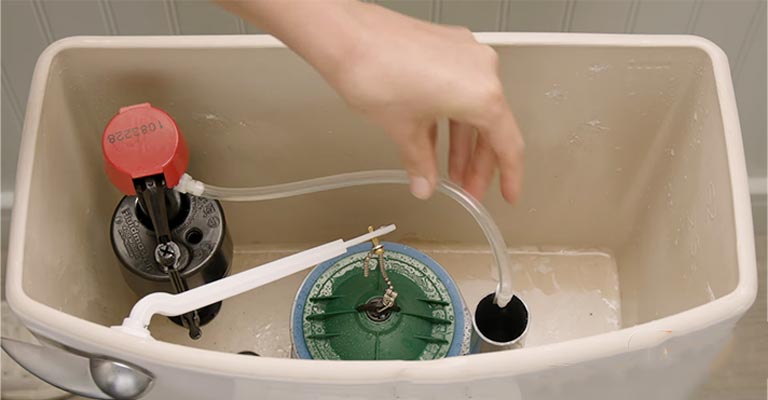A damaged hose clip, excessive water pressure to the tank, and a worn-out bottom seal of the pipe base are the most common reasons why the toilet refill hose keeps coming out.
Furthermore, if the refill tube is positioned incorrectly or too long, the water starts leaking out of it. The broken hose clip needs to be replaced and the water pressure needs to be reduced while troubleshooting this problem.
Then, replace the broken bottom seal. To ensure perfect placement of the fill valve with the tube, it must be cleaned if the tube is clogged.
Find out how to fix the issue effectively by reading the article below. To understand how the refill tube works, you can look at it at the end of this article before moving on to the solutions.
How Can I Prevent The Toilet Tank Hose From Popping Out Of The Tubing?
The right size hose clamp can be used to fix it. Tighten the screw attached to it. Use a spring clamp instead if the diameter is very small.
A stainless steel one should be used since it will be inside the water container. There are times when the seal at the bottom of this drain tube will wear out.
This makes it harder to push down the handle, so when it finally releases, it goes higher and knocks the tube and cap off. It is necessary to replace the bottom seal. There is supposed to be an attachment (often a metal clip) between that tube and the overflow tube.
Putting it down into that larger diameter plastic tube (overflow tube) will lead to it popping out, as you might already have found out.
How To Fix A Toilet Refill Hose That Keeps Coming Out [Easy Solutions]
The following are some of the most common reasons why your toilet refill hose keeps coming out plus solutions.
1. Worn-Out Bottom Seal
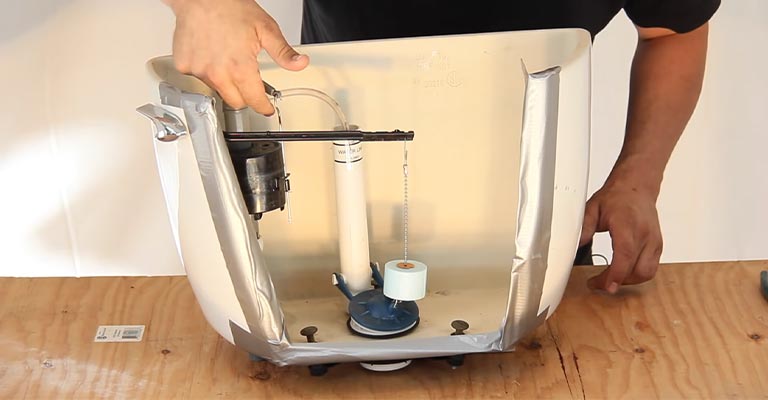
You might need to replace the bottom seal of the pipe base if your toilet refill tube still pops out.
Toilets with tower-style flush valves come with bottom seals. The handle starts popping out of the faucet because of a faulty bottom seal.
The bottom seal needs to be checked and replaced from the bottom. A flush valve seal needs to be purchased according to the size of the toilet flush valve.
Solution:
Start by draining your toilet’s tank and finding the flush valve inside. To drain the remaining water from the tank, flush the toilet.
Locate the flush valve seal by removing the lid from the toilet tank. At the bottom of the flush valve, it is located in a red, blue, or yellow round seal. Pull out the refill tube or remove the clip to remove it.
Make sure the flush valve tower is unhooked from the trip lever. Once the tower assembly has been lifted slightly, lower it back down. To remove it, bend it away from the trip.
The assembly should be lifted off and set aside. The worn valve seal should be removed by pulling it, then the new flush valve seal should be inserted.
Ensures the seal is seated properly. Last but not least, reinstall the flush valve tower assembly. Connect the refill tube and reattach the trip lever.
Turn on the water to the toilet and replace the lid on the toilet tank. Well done! Your toilet tank’s bottom seal has been replaced successfully.
The new flapper needs to be installed on your toilet if it is equipped with a flush valve with a flapper. Once it has been installed, ensure that it can open and close freely.
2. High Water Pressure
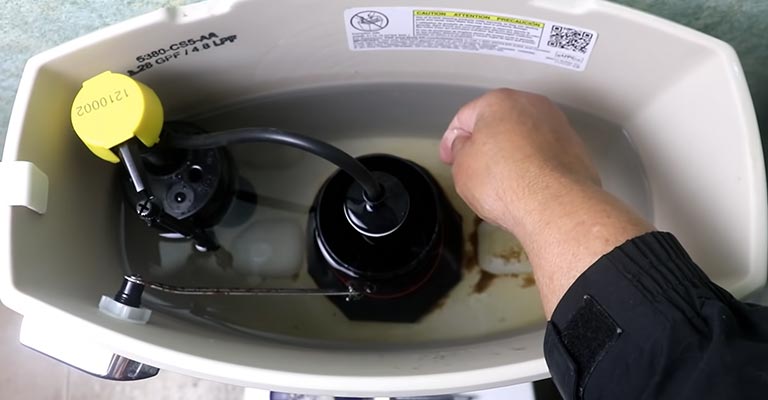
High water pressure usually causes the refill hose to come out. Perhaps the main tank’s water pressure is increasing, causing the hose clip to come loose. This causes the refill tube to leak water.
Alternatively, high water levels in the tank may also be responsible. It is recommended that the water level in the tank is below the overflow tube’s top.
The water level in the tank needs to be adjusted if that is not the case. Follow these steps to complete the process:
Possible Solutions Include:
- Fill valves are connected by float rods and rod balls.
- With the fill valve attached, the rod will be attached to the ball by a tube. The rod will be adjusted by a screw.
- You now need to lower the fill level by bending the float rod down.
- Continually adjust the rod until you reach the desired level.
3. Damaged Refill Hose Clip
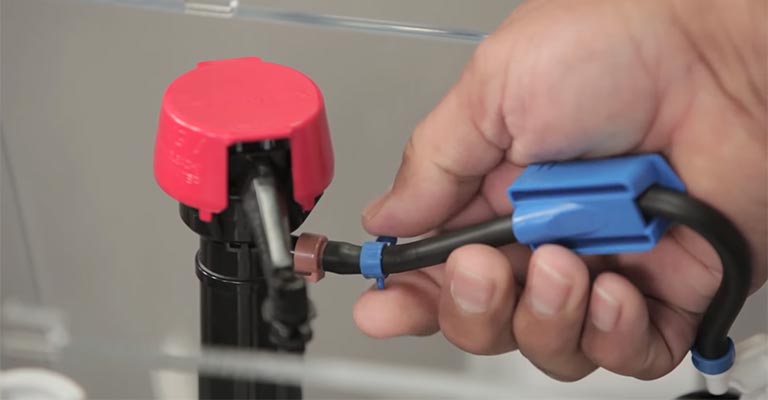
A damaged tube clip is the first thing to look for if your toilet refill tube keeps coming out. This is due to a broken or damaged hose clip, which is why the hose is continually coming out.
To restore the toilet fill valves’ performance, there is an adjacent adapter clip with the refill tube. A metal clip is supposed to attach the refill tube to the overflow tube.
The broken clip in this case causes the refill tube to pop out, wasting a lot of water. Metal clips corrode and lose their effectiveness most of the time.
If you want to resolve this issue, you need to check and replace the broken tube clip. Here are the steps you need to follow:
Solutions:
- Turn off the tank’s water supply first.
- After the tank is empty, carefully remove the hose.
- From the attachment, remove the broken and old hose clip.
- Replace the old clip with the new one and install it.
- In order to avoid corrosion and wear and tear issues, a plastic clip should be purchased there.
- The clip should be connected to the refill and overflow tubes firmly.
- To fill the tank, turn on the water supply.
- Make sure the tube popping problem has been resolved.
If not, proceed to the section below. There are many other options.
4. Clogged Refill Tube
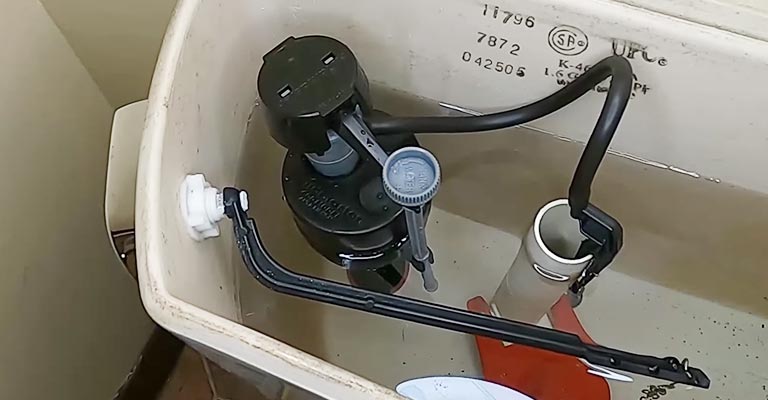
One of the main causes of the tube malfunctioning is a clogged refill tube. If sediment or algae build up inside the refill tube after long wear and tear, it might block the tube.
The refill tube of the toilet will need to be cleaned in this troubleshooting stage.
Solutions:
- Place the hose cleaner in the pipe and insert it from one end to the other.
- If the hose is clogged with sediments, you can carefully sponge the pipe to remove them.
- Place the refill tube back in its place after cleaning.
- Let’s flush the toilet now and check whether the refill tube is no longer leaking water.
5. Refill Tube Is Too Long
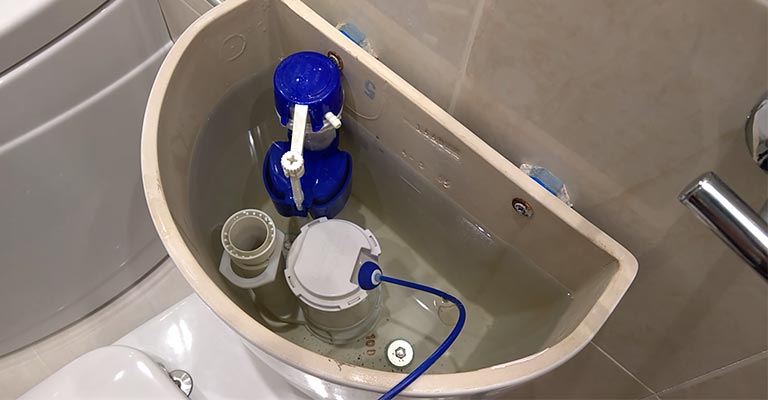
Toilet refill tubes often run continuously if they are too long and do not fit properly in the overflow tube. For this task, you need to shorten the refill tube and make sure the overflow tube is positioned correctly.
Solutions:
- Make sure the water supply is turned off first.
- Remove the refill tube from the overflow tube now.
- Place it just above the opening of the overflow tube.
- You can then trim or cut it off right there.
- Attach it to the overflow tube with a clip. By doing this, you will ensure that the refill tube is placed correctly.
6. Wrong Position Of The Refill Hose
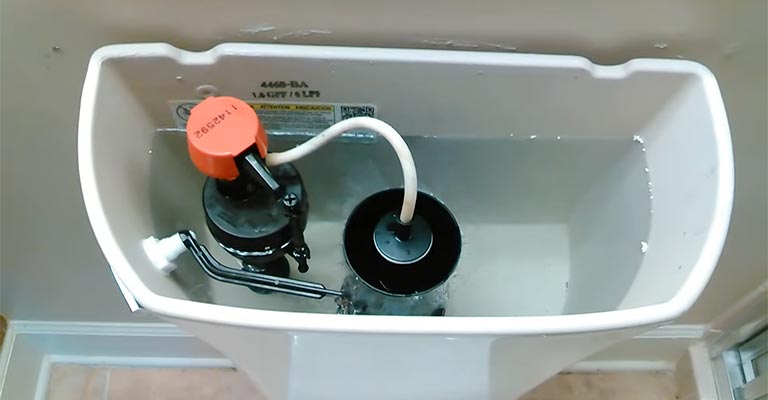
There are times when water starts coming from the refill tube because the refill tube is not positioned properly. There is a possibility that it is not positioned correctly. It is likely that you are wondering how the toilet refill tube needs to be adjusted.
Metal hose clamps are needed for clutching the refill tube in its original position. A tube will be attached to a fitting and sealed. As well as sealing the connection, it prevents fluid leakage.
Possible Solutions:
Toilet refill tubes come with hose clamps. Replace the refill tube with a new metal hose clamp.
7. The Defective Refill Hose Needs To Be Replaced
You should make sure the refill tube is faulty if none of the above troubleshooting methods resolve the issue. Replacement of the toilet refill tube is the only solution. If your refill hose is defective, follow these steps:
How To Replace Toilet Refill Tube
- Turn the water supply valve handle clockwise to turn off the water flow to the tank.
- To drain the tank water, take off the tank lid and flush the toilet.
- Next, disconnect the refill tube from one end where it connects to the fill valve.
- Twist the tube back and forth to remove it from the fill valve
- Remove the other end of the refill hose from the top of the overflow tube next.
- To remove the holding clip, pull it out of the tube’s end.
- Place the new refill tube in the correct position.
- Put one end of the holding clip into one end of the tube.
- After that, cross the tube’s other end over the nipple.
- Refill tubes must be closely connected to fill valves.
- Over the edge of the overflow tube, connect the tube clip.
- You should also make sure that the tube is pointing inside the overflow tube at one end.
- Fill the water tank by turning the water supply counterclockwise.
- Reconnect the tank lid to the tank.
Frequently Asked Questions
1. What Is Toilet Refill Tube And How Does It Work?
Refill tubes are integral parts of toilet tanks, where they interact closely with overflow tubes and fill valves.
Its primary function is to signal the overflow tube how much water it should input into the bowl. From one side, the refill tube is connected to the fill valve.
Directly into the flapper is the drain on the bottom side. Fill valves signal tanks to refill. A portion of the incoming water flows into the refill tube. After flowing into the overflow tube, the flapper dumps clean water into the bowl.
The water will come out of the refill tube if the refill tube is not connected to the fill valve or if there is stuck debris in it.
2. Are All Toilet Fill Valves The Same Size?
It’s not! There is a difference in the size of the toilet fill valves. Depending on the toilet design, the size will vary. 2 to 4 inches is the most common size.
3. How Do You Fix A Toilet Fill Valve That Keeps Running?
It is important to position the toilet fill valve correctly in order to fix the running toilet fill valve. Afterwards, clean out the clogged debris. It should be replaced if it is still running.
4. Is The Fill Tube Supposed To Be In The Overflow Tube?
There should be a connection between the refill tube of the tank and the overflow tube. The overflow tube should always be above it. The water will start flowing backward, keeping the tube full if that does not happen.
Final Words
It has been our goal to explore every single detail regarding the toilet fill tube that isn’t working in this article. The above guide should assist you in effectively troubleshooting your toilet problem.

